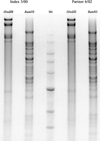Recurrent antiviral-resistant genital herpes in an immunocompetent patient
- PMID: 15942905
- PMCID: PMC4265802
- DOI: 10.1086/430612
Recurrent antiviral-resistant genital herpes in an immunocompetent patient
Abstract
Herpes simplex virus type 2 (HSV-2) resistance to antiviral drugs has been described primarily in immunocompromised patients. We report an apparently immunocompetent, human immunodeficiency virus-negative male patient who has experienced repeated HSV-2 genital outbreaks despite receiving antiviral prophylaxis with several different drugs. Several of the HSV-2 genital isolates from this patient have been confirmed as resistant to acyclovir and penciclovir. Antiviral resistance occurred in the setting of long-term prednisone treatment and intermittent acyclovir prophylaxis at suboptimal doses and persisted despite the cessation of oral steroid treatment. The patient's genital herpes outbreaks were not controlled by high-dose prophylaxis with acyclovir, valacyclovir, and famciclovir. Cessation of antiviral prophylaxis resulted in reversion of this patient's HSV-2 isolates to acyclovir and penciclovir sensitivity, although resistant virus reappeared when antiviral prophylaxis was resumed. Transmission of a sensitive HSV-2 strain from this patient to a female sex partner was observed. These observations confirm previous reports that resistance to acyclovir may develop during prophylactic therapy in an otherwise well, immunocompetent patient. These findings support the conclusion that both drug-sensitive and drug-resistant HSV-2 strains established latency in this patient and that both strains are capable of frequent reactivation.
Figures

Similar articles
-
Resistance of herpes simplex viruses to nucleoside analogues: mechanisms, prevalence, and management.Antimicrob Agents Chemother. 2011 Feb;55(2):459-72. doi: 10.1128/AAC.00615-10. Epub 2010 Nov 15. Antimicrob Agents Chemother. 2011. PMID: 21078929 Free PMC article. Review.
-
Profiling penciclovir susceptibility and prevalence of resistance of herpes simplex virus isolates across eleven clinical trials.Arch Virol. 2003 Sep;148(9):1757-69. doi: 10.1007/s00705-003-0124-7. Arch Virol. 2003. PMID: 14505088 Clinical Trial.
-
Treatment of acyclovir-resistant herpetic ulceration with topical foscarnet and antiviral sensitivity analysis.Dermatology. 1998;197(3):278-80. doi: 10.1159/000018014. Dermatology. 1998. PMID: 9812037
-
Frequent genital herpes simplex virus 2 shedding in immunocompetent women. Effect of acyclovir treatment.J Clin Invest. 1997 Mar 1;99(5):1092-7. doi: 10.1172/JCI119237. J Clin Invest. 1997. PMID: 9062368 Free PMC article. Clinical Trial.
-
Valaciclovir: a review of its long term utility in the management of genital herpes simplex virus and cytomegalovirus infections.Drugs. 2000 Apr;59(4):839-63. doi: 10.2165/00003495-200059040-00013. Drugs. 2000. PMID: 10804039 Review.
Cited by
-
Diagnostics for herpes simplex virus: is PCR the new gold standard?Mol Diagn Ther. 2006;10(1):17-28. doi: 10.1007/BF03256439. Mol Diagn Ther. 2006. PMID: 16646574 Review.
-
Resistance of herpes simplex viruses to nucleoside analogues: mechanisms, prevalence, and management.Antimicrob Agents Chemother. 2011 Feb;55(2):459-72. doi: 10.1128/AAC.00615-10. Epub 2010 Nov 15. Antimicrob Agents Chemother. 2011. PMID: 21078929 Free PMC article. Review.
-
Single-day famciclovir for the treatment of genital herpes: follow-up results of time to next recurrence and assessment of antiviral resistance.Curr Med Res Opin. 2009 Feb;25(2):483-7. doi: 10.1185/03007990802664678. Curr Med Res Opin. 2009. PMID: 19192993 Free PMC article. Clinical Trial.
-
Development and evaluation of a host-targeted antiviral that abrogates herpes simplex virus replication through modulation of arginine-associated metabolic pathways.Antiviral Res. 2016 Aug;132:13-25. doi: 10.1016/j.antiviral.2016.05.009. Epub 2016 May 15. Antiviral Res. 2016. PMID: 27192555 Free PMC article.
-
Fulminant, acyclovir-resistant, herpes simplex virus type 2 hepatitis in an immunocompetent woman.J Clin Microbiol. 2006 Apr;44(4):1584-6. doi: 10.1128/JCM.44.4.1584-1586.2006. J Clin Microbiol. 2006. PMID: 16597901 Free PMC article.
References
-
- Fleming DT, McQuillan GM, Johnson RE, et al. Herpes simplex virus type 2 in the United States, 1976 to 1994. N Engl J Med. 1997;337:1105–1111. - PubMed
-
- Cusini M, Ghislanzoni M. The importance of diagnosing genital herpes. J Antimicrob Chemother. 2001;47(Suppl T1):9–16. - PubMed
-
- Reichman R, Badger G, Mertz G, et al. Treatment of recurrent genital herpes simplex infections with oral acyclovir. JAMA. 1984;251:2103–2107. - PubMed
-
- Marques AR, Straus SE. Herpes simplex type 2 infections—an update. Dis Mon. 2000;46:325–359. - PubMed
-
- Leung DT, Sacks SL. Current recommendations for the treatment of genital herpes. Drugs. 2000;60:1329–1352. - PubMed
Publication types
MeSH terms
Substances
Grants and funding
LinkOut - more resources
Full Text Sources
Other Literature Sources
Medical

